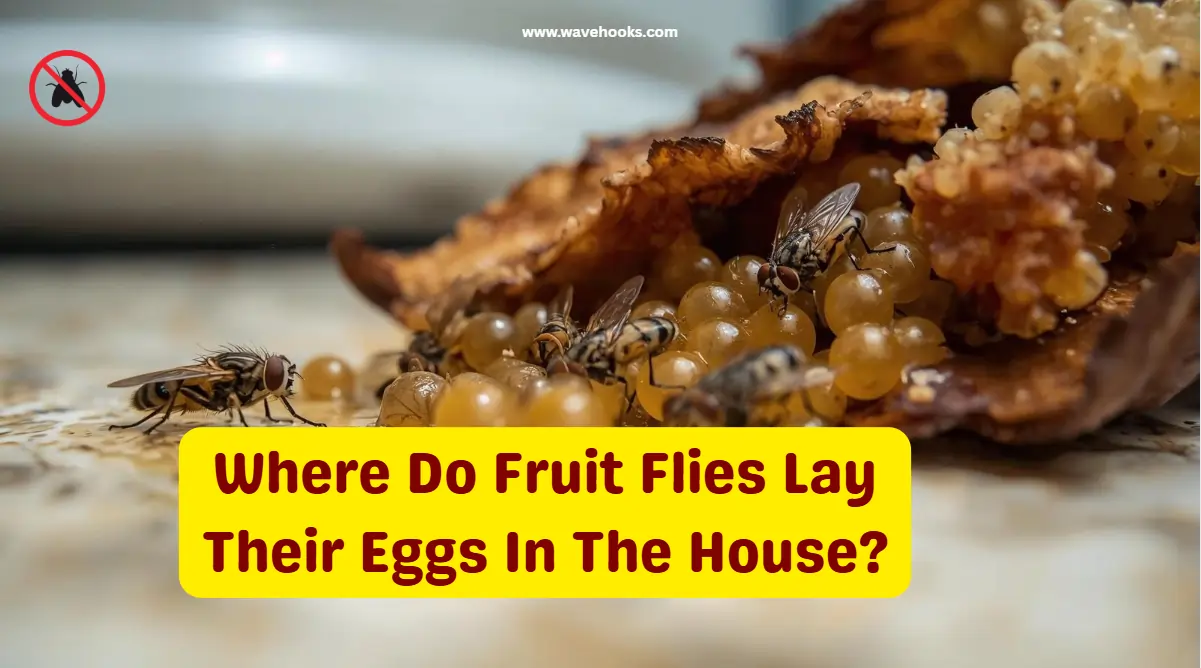Where do fruit flies lay their eggs in the house? That’s the question I asked myself one summer evening when I couldn’t figure out why they kept coming back.
And if you are also asking the same thing, you’re not alone. These pests aren’t just annoying. They multiply at a shocking speed.
This guide helps you find where fruit flies lay their eggs in the house. These tricks, backed by real stories, will help you reclaim your home this season.
Let’s dive in before they take over your counters, drains, and peace of mind.
What Are Fruit Flies?
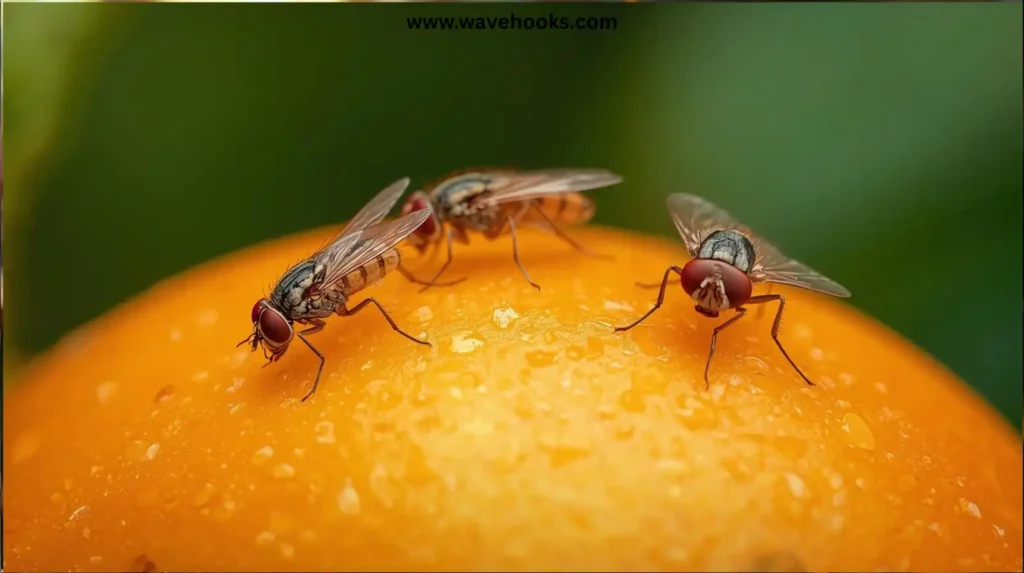
If you’ve ever left fruit out “just for a bit” and come back to tiny brown flies everywhere, you’ve met fruit flies.
They’re small, sneaky, and good at finding fermenting food. They sneak in through open windows, grocery bags, or even the tiniest cracks in your kitchen.
One female can lay hundreds of eggs, and within a day, they start hatching. That’s why one or two flies can suddenly feel like a full-blown infestation.
I learned this the hard way with a single overripe mango that turned into a week-long fly frenzy.
Suggested Read: How To Get Rid Of Fruit Flies In Apartment: 13 Simple Tricks
Why Fruit Flies Are a Common Household Nuisance
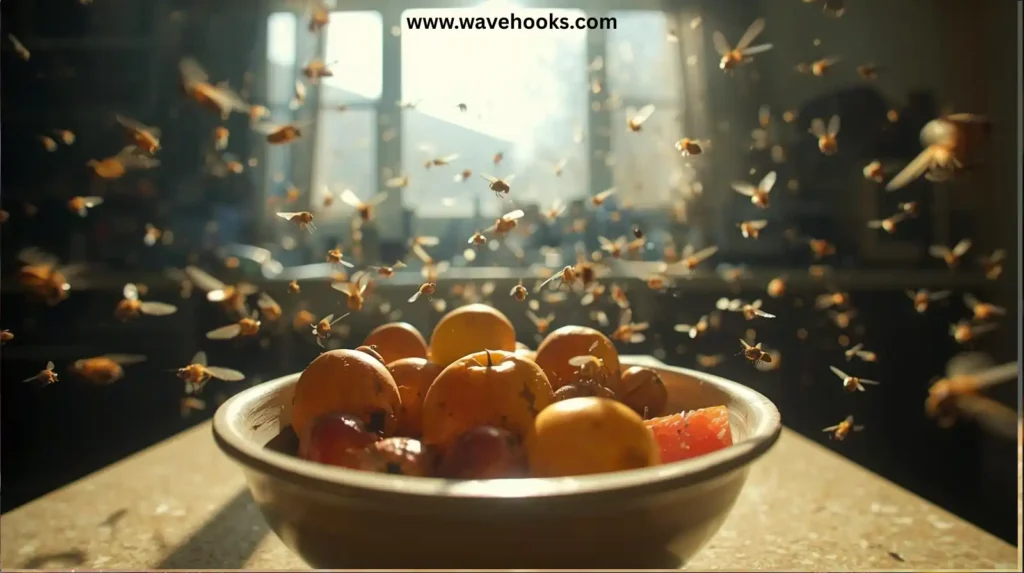
I’ll never forget the morning I left a bunch of bananas on the counter “just for a few hours.” By noon, tiny flies were buzzing everywhere.
Frustrating, right? That’s fruit flies for you. They can smell ripening fruit from far away and are experts at finding even the tiniest spill or crumb.
One female can lay hundreds of eggs, so a single banana peel can start a mini invasion.
They won’t disappear, but they stick around until the source is gone. I ended up chasing flies around my kitchen for days before figuring out what was feeding them.
Understanding the Fruit Fly Life Cycle
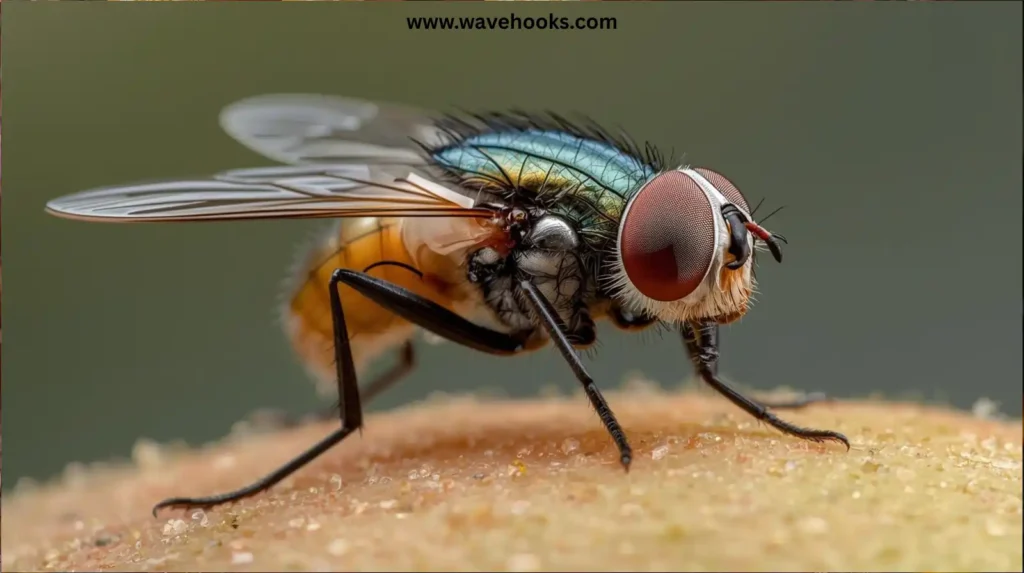
Fruit flies live life in fast-forward. An egg can hatch into a larva in less than 24 hours. If you don’t act fast, they multiply before you even notice
That larva chews on whatever food scraps it can find, like banana peels, forgotten salad leaves, even crumbs in the drain.
A few days later, it becomes a pupa, and soon after, a new adult buzzes around your kitchen, ready to lay eggs.
I remember seeing just a couple of flies multiply into dozens overnight. Summer is the worst. They thrive in warm, humid kitchens.
How to Identify Fruit Fly Eggs and Larvae
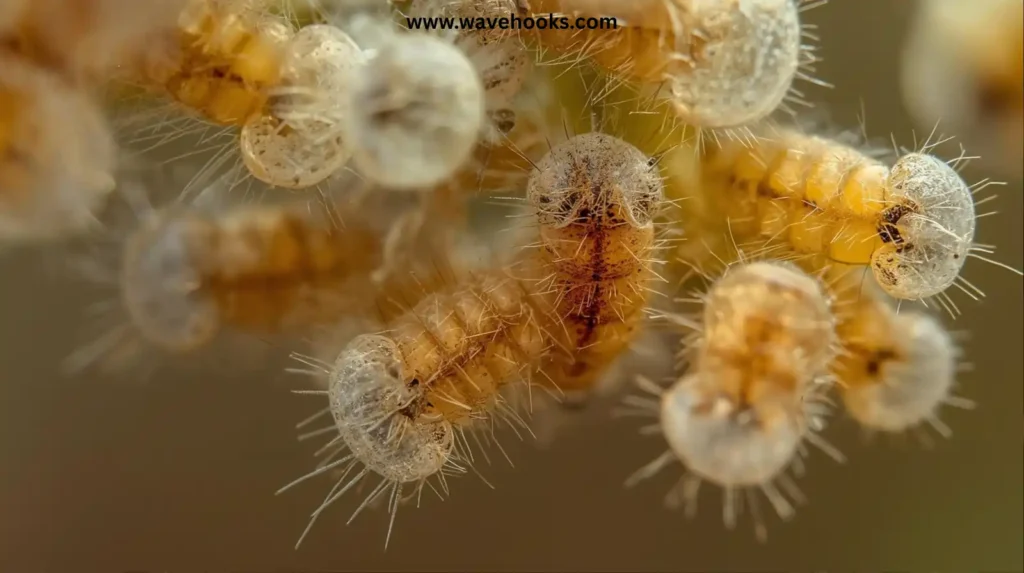
Spotting these tiny pests is tricky because they are in size of 0.5mm long.
Fruit fly eggs are almost invisible as they are tiny, white, and often tucked in soft fruit or damp areas.
Within a day, they hatch into cream-colored larvae, wriggling around and feeding on decaying matter.
I once opened a rotten tomato and was shocked by the tiny wrigglers inside. The key is catching them early.
Toss spoiled food, scrub your drains, and keep an eye on compost. If you do it quickly, you can stop them before they become adults buzzing around your kitchen all day.
How Long Do Fruit Flies Live?
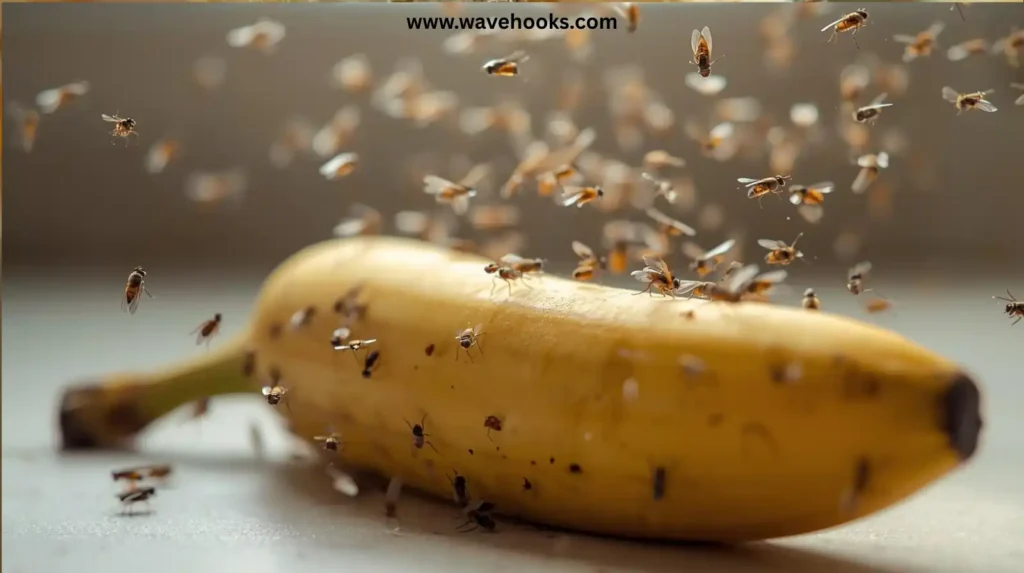
Fruit flies don’t live long, maybe 40 to 50 days, but they don’t need to. Their life cycle is just 8–10 days from egg to adult,
A single female can produce several generations in one month. Warm, humid kitchens speed up the process.
I remember leaving a few bananas out for a day, thinking nothing would happen, and the next morning, it seemed like my entire kitchen was buzzing.
Without removing the food source, they multiply fast. It feels like they’re everywhere, but really, it’s just rapid reproduction in action.
Suggested Read: 12 Crazy Tricks On How To Wash Bananas To Prevent Fruit Flies
Why Fruit Flies Multiply Faster in Seasonal Kitchens
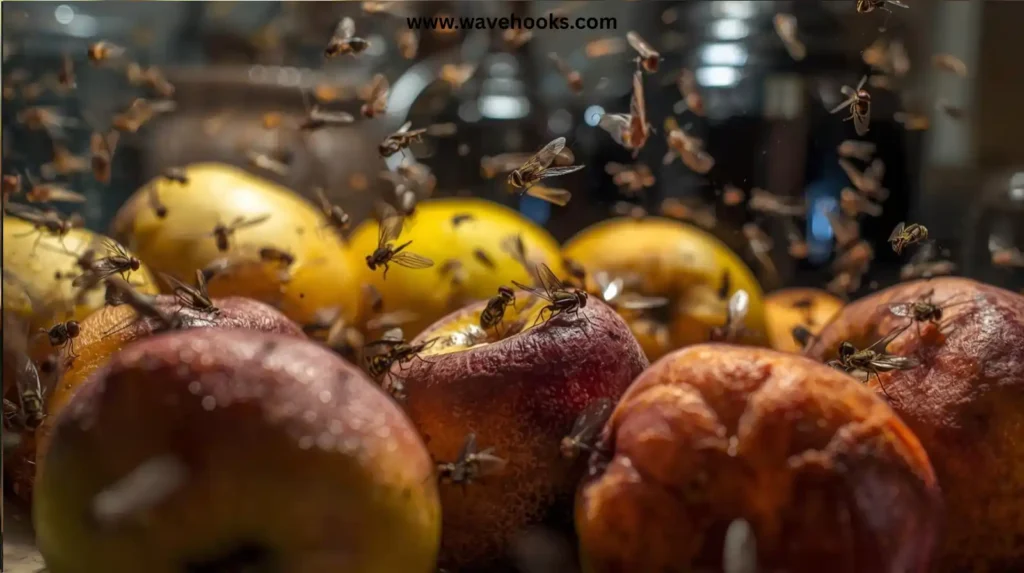
Late summer and fall kitchens are a paradise for fruit flies. Warm air, ripening fruit, and frequent cooking all combine into a perfect storm.
I remember visiting a friend in September, her counters held apples from a local orchard, and within hours, tiny flies appeared.
Research from the University of Florida shows fruit flies develop from egg to adult in as little as eight days in warm weather.
That means your home can host several overlapping generations in just one month. Without prevention, infestations feel endless.
Understanding where fruit flies lay their eggs in the house and how to block them becomes essential, especially during seasonal transitions.
Hidden Places Where do Fruit Flies Lay Their Eggs in the house
Here are the places you can check:
1. Overripe Fruits on the Counter

Leave a banana out for two days and you’ll see visitors. Fruit flies smell ripening fruit from miles away, and females lay up to 500 eggs in the soft peel. Eggs hatch in 24 hours. Always refrigerate ripe fruit or cover bowls with a mesh to break their life cycle.
2. Vegetable Baskets
Tomatoes and potatoes release ethylene gas as they ripen, which instantly attracts fruit flies. A study from Cornell University notes that fruit flies double in activity at 27°C. Keep vegetables in cool, dry storage instead of uncovered baskets to avoid creating the perfect egg-laying environment in your kitchen.
3. Kitchen Trash Bins
Your trash bin is paradise for flies, warm, moist, and full of rotting scraps. According to Orkin, most infestations start in garbage areas. If bins aren’t emptied daily, eggs hatch quickly inside. Use tight-sealed lids and wash bins weekly with vinegar water to kill any hidden larvae.
4. Compost Buckets
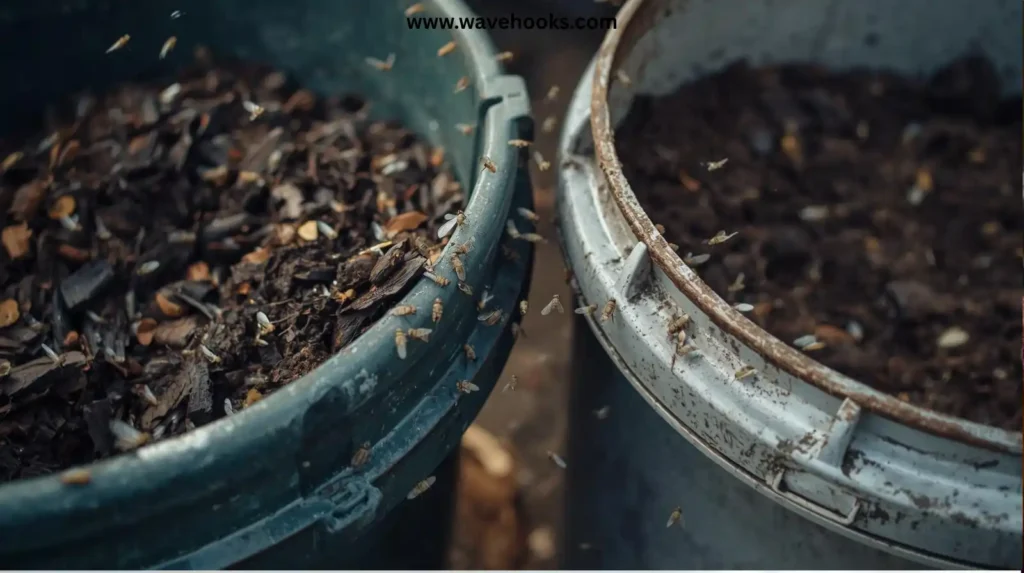
Indoor compost is eco-friendly but dangerous if left uncovered. Fruit flies swarm the damp organic matter, laying eggs in decomposing scraps. Since their life cycle completes in 8–10 days, even short neglect leads to a colony. Keep compost outside, sealed, or sprinkled with dry leaves to reduce breeding.
5. Drains and Sinks
Slimy film inside drains is a hidden breeding hub. Female flies drop eggs where moisture and food particles accumulate. PestWorld reports that 80% of infestations trace back to drains. Clean weekly with boiling water or baking soda and vinegar flushes to kill eggs before they hatch in 24 hours.
6. Dish Sponges
That damp sponge on the sink? It’s basically a fruit fly nursery. Microscopic food bits stick to fibers, keeping them moist. Studies show larvae can survive on porous surfaces for days. Replace sponges weekly, wring them dry, and microwave for 30 seconds to kill any hidden eggs or larvae.
7. Recycling Bins: Juice or Soda Bottles
Empty soda cans or beer bottles carry sticky residues that ferment fast, pulling in flies. Eggs are often laid around the bottle rim where sugar settles. The USDA confirms fermented residues are the top attractant. Always rinse recyclables before tossing them in bins, or store bins outside.
Suggested Read: 12 Expert Hacks For How To Get Rid Of Cluster Flies Easily!
8. Leaky Pipes Under the Sink
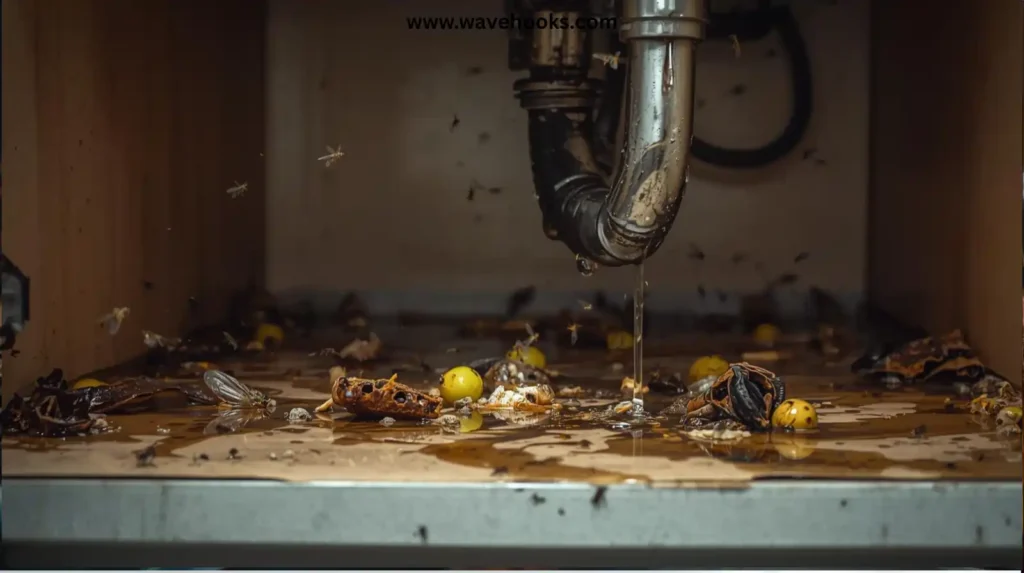
Leaks leave behind waterholes that mix with food particles, forming an ideal moist film. This dampness encourages females to lay clusters of eggs. Research shows that moist areas increase egg survival rates by 70%. Fix leaks promptly and clean under the sink with disinfectant to eliminate breeding grounds.
9. Mop Buckets with Dirty Water
A mop bucket left standing overnight is worse than you think. The mix of water and decomposing particles smells like a buffet to flies. Within 24 hours, eggs hatch into larvae feeding off organic matter. Always empty buckets after use, rinse thoroughly, and let them air dry to stop infestations.
10. Fruit Bowls with Hidden Rot
One apple with a soft spot is enough. Fruit flies detect ripening gases instantly and burrow into soft flesh to lay eggs. Since females lay 50–70 eggs per batch, one neglected apple starts an invasion. Inspect fruits daily, discard spoiled ones, and wash bowls to eliminate sugary residues.
11. Open Wine or Beer Bottles
Fruit flies love fermentation. It’s their survival fuel. Leave a wine glass or beer bottle out, and within hours, they’ll lay eggs near the rim. Studies in the Insect Behavior Journal confirm that fermented alcohol is a prime egg-laying Place. Always rinse bottles and cover glasses to stop them mid-cycle.
Suggested Read: What To Do With Vintage Glass Bottles: 16 Top Creative Ideas!
12. Pet Food Bowls
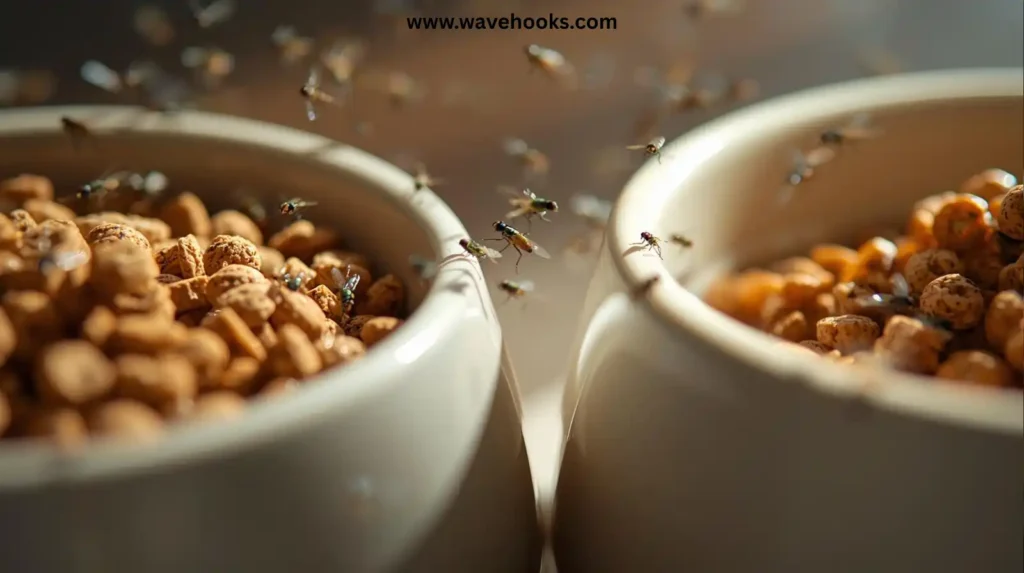
Leftover pet food is a magnet. Soft kibble absorbs moisture, turning into a breeding site. In warm kitchens, eggs hatch in under 24 hours. Wash pet bowls after every meal, and avoid leaving wet food out for hours. A clean feeding space keeps both pets and homes safe.
13. Damp Towels or Rags in the Kitchen
Fruit flies don’t just need sugar. They need moisture. Damp rags with crumbs provide both. USDA reports that flies thrive in environments with 70% humidity or higher, making wet towels risky. Wash or dry clothes daily and hang them outside to keep fabric from turning into egg-laying zones.
14. Pantry Items like Potatoes, Onions, Garlic
Stored in dark corners, potatoes and onions sprout, giving off gases that attract flies. Once skins soften, females insert eggs easily. Studies show flies prefer crevices and cracks in vegetables for larval survival. Keep pantry items cool, dry, and regularly inspected to avoid a hidden infestation building inside.
15. Potted Plants with Damp Soil
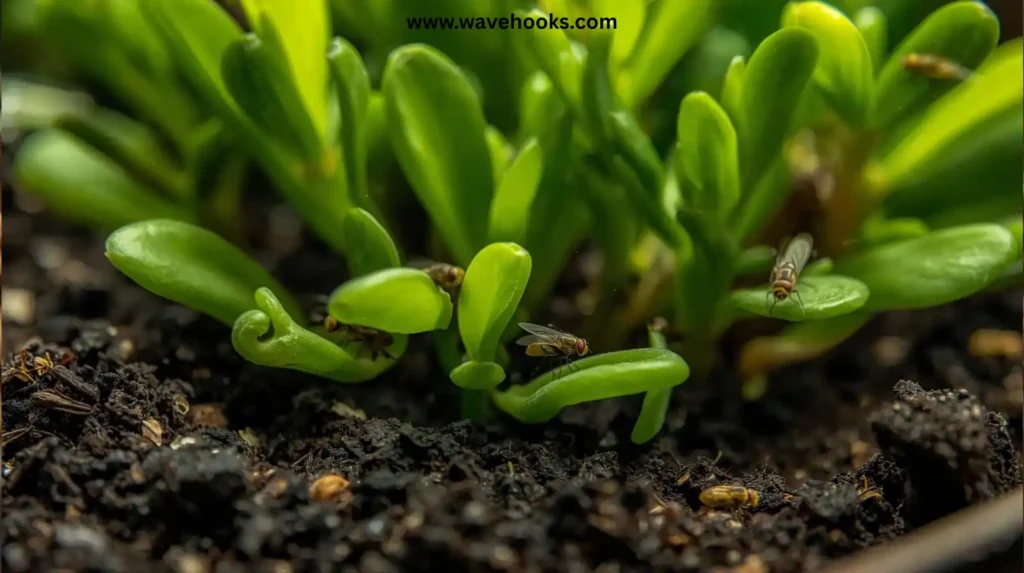
Overwatered houseplants create moist soil rich in decomposing organic matter. Fruit flies mistake it for compost and lay eggs near roots. A single female can produce 500+ offspring here in weeks. Let the soil dry between waterings and sprinkle cinnamon powder, which naturally deters larvae from maturing underground.
16. Refrigerator Drawers
Refrigerators can also host flies. Forgotten cucumbers or lettuce in drawers rot slowly, becoming breeding sites. Since eggs can survive at cooler temperatures for longer incubation, infestations spread silently. Clean drawers weekly, check expiration dates, and store produce in sealed containers to block flies from accessing it.
17. Empty Pizza Boxes or Takeout Containers
Even a “clean” pizza box holds grease stains that ferment overnight. Fruit flies detect those oils quickly. According to pest studies, cardboard retains organic odor particles for days. Dispose of boxes immediately and rinse food containers before recycling. A single box can trigger dozens of new flies.
18. Broken Floor Tiles or Cracks

Cracks collect tiny crumbs and moisture, invisible to you but gold for fruit flies. Females deposit eggs inside these protected spaces, making removal tough. University studies confirm flies choose crevices for egg protection. Sweep and vacuum regularly, then seal cracks with caulk to keep pests from hiding there.
Suggested Read: 15 Shocking Reasons Why Do Roaches Keep Coming Back?
19. Microwave or Oven Trays
Spilled sauce inside the microwave or crumbs on the oven trays provide warmth and food. Fruit flies can detect these spots within hours. Research shows flies breed faster near heated residues, doubling egg hatching speed. Always wipe trays after use and do a weekly deep clean to block their cycle.
20. Laundry Baskets with Damp Clothes
Juice-stained shirts or beer-soaked towels tossed in a basket are secret breeding zones. Fruit flies thrive on sugary residues in damp fabrics. Eggs survive longer in warm, humid laundry rooms with 70–80% humidity. Wash stained clothes promptly and keep laundry baskets dry to stop larvae from growing unnoticed.
Best Tricks To Stop Fruit Flies
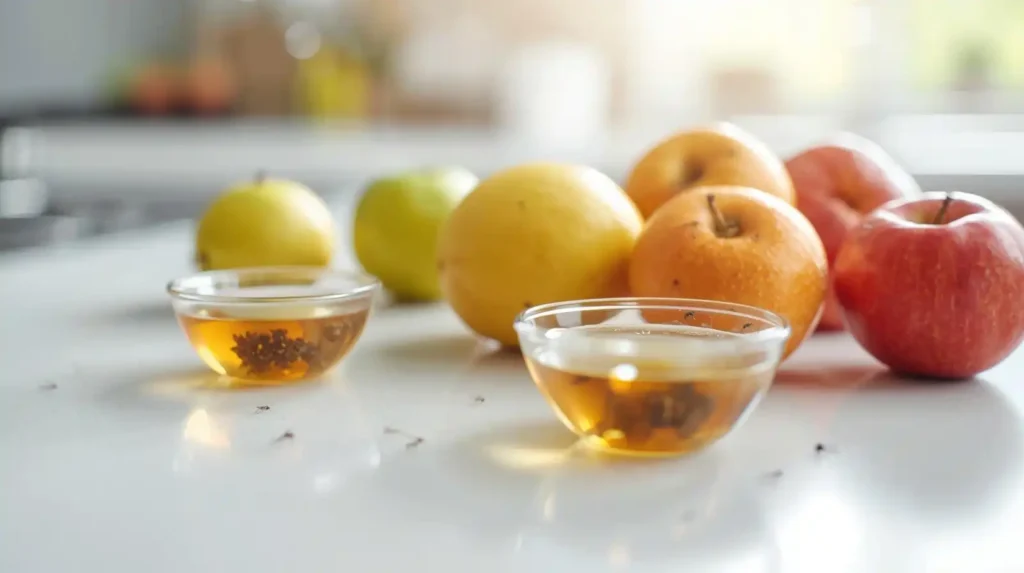
Fruit flies are the tiny kitchen invaders you never see coming. One minute your fruit bowl is fine, the next, it’s buzzing with flies.
I’ve learned a few tricks over the years that actually work. Here are tips that will save your kitchen:
1. Deep Clean Kitchen Drains – I once ignored a smelly sink, and flies came out of everywhere. Running boiling water, followed by vinegar and baking soda, cleared the hidden eggs. Now, I scrub weekly and haven’t seen a fly rise from my drain.
2. Seal Fruits in Airtight Containers – Leaving bananas in a bowl used to be a mistake, I’d wake up to swarms. Switching to glass containers changed everything. Covered fruit keeps flies away and makes groceries last longer.
3. Empty Trash Every Night– I used to think my trash was fine overnight. Big mistake. Flies love even half-full bins. Emptying them daily and adding lemon peels keeps odors away and stops egg-laying.
4. Scrub Sponges and Dishcloths – My sponge was secretly a breeding ground. A quick microwave zap or replacing it weekly keeps hidden colonies gone. It’s a tiny change that makes a huge difference.
5. Apple Cider Vinegar Traps – I set up a jar with vinegar and dish soap as a joke once. By morning, dozens of flies had trapped themselves. Simple, cheap, and shockingly effective.
6. Use Essential Oils – Lavender and eucalyptus aren’t just pleasant scents, but they keep flies away. I leave cotton balls around the kitchen, and it smells like a spa, not a bug haven.
Suggested Read: 45 Crazy Ways How To Get Rid Of Wood Boring Bees Overnight
Real-Life Story: The Family That Won the Battle
Last August, a Chicago family faced what they called a “fruit fly invasion.”
They assumed bananas were the cause, but deeper checks revealed eggs inside their sponge, trash bin, and even half-empty wine bottles.
The frustration was overwhelming; they nearly canceled a weekend party. After applying tricks consistently, the infestation reduced by 90% in just one week.
Their story highlights how knowing where do fruit flies lay their eggs in the house is half the battle. The rest is persistence.
Suggested Read: What Smell Keeps Bees Away? 12 Proven Scents That Work!
Seasonal Prevention Checklist
When warm weather arrives, prevention is key. Here’s my seasonal checklist:
- Emptying trash and recycling every night.
- Covering fruits, refrigerating overripe.
- Wiping sticky spills within minutes.
- Rinse bottles and jars before recycling.
- Clean drains weekly with vinegar and boiling water.
- Keep compost sealed.
- Inspect groceries carefully.
Following these habits cuts infestations drastically. A CDC report warns that fruit flies can transfer bacteria like E. coli from trash to counters.
These will guarantee your home to stay fresh, healthy, and fly-free throughout the year, even during peak summer and fall.
FAQs: where do fruit flies lay their eggs in the house
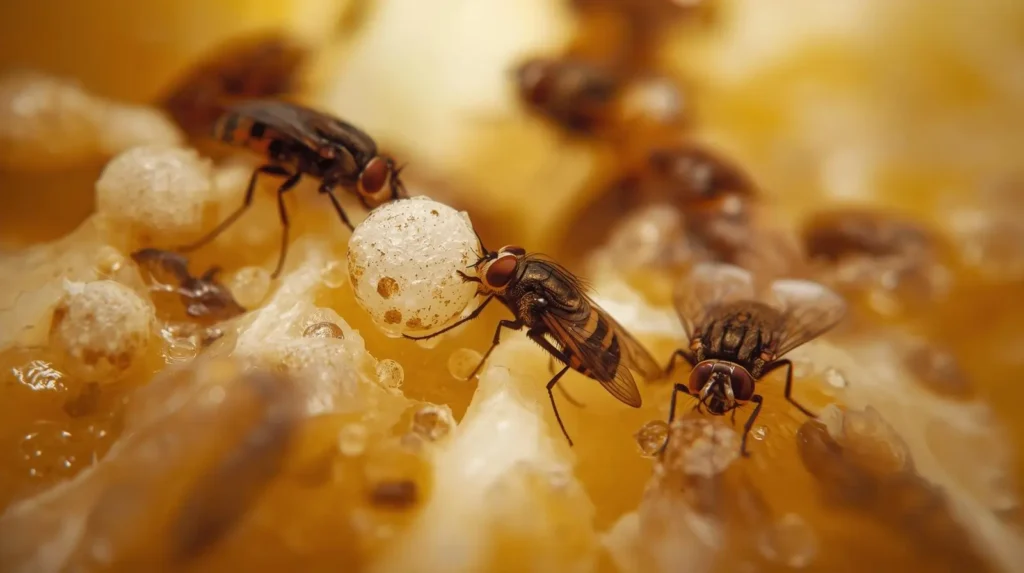
1. Where do fruit flies lay their eggs in the house during summer?
During summer, fruit flies target drains, trash bins, sponges, recycling, and overripe fruit. Warm weather speeds their life cycle, so eggs hatch in less than 24 hours. That means if you miss a spill or leave fruit exposed, you’ll see adults almost immediately.
2. Can fruit flies lay eggs in houseplants?
Yes. Overwatered soil provides moisture and organic matter that flies love. Adding sand to the surface creates a dry barrier, making it harder for them to breed. I once discovered flies hovering over my basil until I made this change. Now, no pests appear, and the plants thrive without becoming hidden nurseries.
3. How many eggs can a fruit fly lay indoors?
A female fruit fly lays up to 500 eggs in 10 days. That’s why infestations grow so rapidly. Even a small food spill or forgotten fruit can multiply into hundreds of flies quickly. Knowing exactly where fruit flies lay their eggs in the house allows you to break this cycle early.
4. Are fruit flies dangerous in the kitchen?
While fruit flies don’t bite, they’re far from harmless. The CDC warns they can carry pathogens like E. coli and Salmonella from trash or drains onto food preparation surfaces. This increases health risks, especially for children and pets. That’s why removing breeding sites is important for your family’s health.
5. What kills fruit fly eggs instantly?
Boiling water, vinegar-baking soda mixtures, and freezing scraps all destroy eggs instantly. Freezing food waste before disposal also prevents infestations. Combining these methods ensures you’re targeting eggs at multiple levels, stopping them before they hatch into full-blown nuisances.
Suggested Read: 15 Homemade Roach Killer Safe For Pets That Works Like Magic!
Conclusion: where do fruit flies lay their eggs in the house
Now you know where do fruit flies lay their eggs in the house, from drains and trash bins to sponges.
More importantly, you’ve learned practical tricks to break their breeding cycle.
Take action tonight: pick three tricks, whether sealing fruit, cleaning drains, or refrigerating produce, and apply them immediately.
Within days, you’ll see the transformation. Don’t let flies steal your comfort another season. Your fresh, fly-free kitchen awaits.

